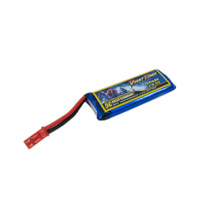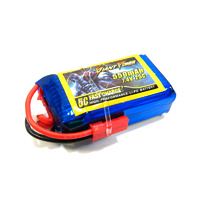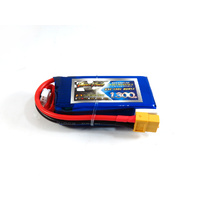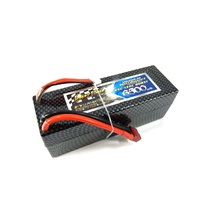Related Content
Understanding Lipo Batteries
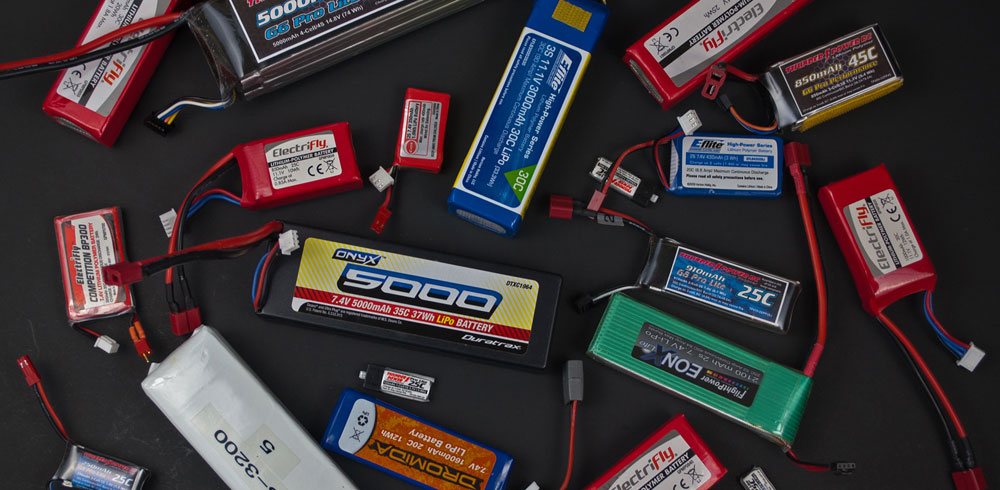
Lipo batteries (short for Lithium Polymer) are a type of rechargeable battery that has taken the electric RC world by storm. When compared to their old NiCd/NiHm batteries, there are 3 main points that make them a better option:
- Are light weight and can be made in almost any shape and size.
- Have large capacities, meaning they hold lots of power in a small package.
- Have high discharge rates to power the most demanding electrics.
- Offer a far more steady discharge curve, holding "peak" voltage for longer.
Lipo RC Battery Ratings
These are the three main numbers you will need when going battery shopping.
- Voltage (or "S")
- Capacity (mAh)
- Discharge Rate (or "C" )
What do the ratings mean?
Voltage or "S" Rating
Unlike conventional NiCad or NiHm battery cells that have a voltage of 1.2 volts per cell, Lipo battery cells are rated at 3.7 volts per cell and 4.2 volts when fully charged. The benefit here is fewer cells can be used to make up a battery pack, and in some cases on smaller micro sized RC aircrafts, like Blade mCX's, mSR, or 120 SR, one 3.7 volt cell is all that is needed to power the model.
Other than the smallest of electric RC models, RC Lipo battery packs will have at least two or more cells hooked up in series to provide higher voltages. For larger RC models, that number can be as high as 6 cells, and even more for larger birds or HV (high voltage) applications.
Here is a list of Lipo RC battery pack voltages with cell counts most beginners will be using;
- 3.7 volt battery = 1 cell x 3.7 volts (1S)
- 7.4 volt battery = 2 cells x 3.7 volts (2S)
- 11.1 volt battery = 3 cells x 3.7 volts (3S)
- 14.8 volt battery = 4 cells x 3.7 volts (4S)
- 18.5 volt battery = 5 cells x 3.7 volts (5S)
- 22.2 volt battery = 6 cells x 3.7 volts (6S)
If you are wondering what the number in parenthesis means, it is a way the battery manufacturers indicate how many cells hooked in series "S" the battery pack contains.
Battery packs can also be wired in parallel to increase the capacity. This is indicated by a number followed by a "P". Example: 3S2P would indicate 2 x three celled series packs hooked up in parallel to double the capacity.
Capacity or "mAh" Rating
Capacity indicates how much power the battery pack can hold, and how long it will take to be flat based on the load you put on it. Capacity is measured in milliamps hours (mAh). On larger capacity batteries (such as 12v car lead acid batteries) this rating is measured as amps hours (ah).
As an example, an RC Lipo battery that is rated at 1000 mAh would be completely discharged in one hour with a 1000 milliamp load placed on it. If this same battery had a 500 milliamp load placed on it, it would take 2 hours to drain down. If the load was increased to around 15,000 milliamps (15 amps), a very common current drain in a 400 sized RC helicopter while hovering, the time to drain the battery would be only about 4 minutes.
As you can see, for an RC model with that kind of current draw, it would be very advantageous to use a larger capacity battery pack, such as a 2000 mAh pack or even higher. This larger pack used with a 15 amp draw would double the time the pack would take to discharge. This calculation is a fine balance, as the bigger the capacity (and running time), the bigger the battery and its total weight. There is always going to be a weight threshold. A really high capacity battery is great, but not if your model is unable to carry it! Understanding the weight that your model can handle is also a crucial factor in how big a battery you can use.
Overall, the main thing to get out of this if you want more running time, increase the capacity of your battery pack. Unlike voltage, capacity can be changed around to give you more or less running time.
Discharge Rate or "C" Rating
This is probably the single most over rated and misunderstood of all battery ratings. Discharge rate is simply how fast a battery can be discharged safely. The faster the ions can flow from anode to cathode in a battery will indicate the discharge rate. In the RC Lipo battery world, it is called the "C" rating.
A battery with a discharge rating of 20C would discharge it at a rate 20 times more than the capacity of the pack, a 30C pack = 30 times more, a 40C pack = 40 times more, and so on. In our experience, it never pays to push a battery at its maximum C rating. Manufacturers always specify very high C ratings and it always pay to have as much head room as possible. If you were to purchase a 20c rated 1200mah battery and put a 20c load on it for the duration of the use (20x120mah is 24,000mah or 24amps) you can guarantee that this battery would be very hot at the end, and over time would deteriorate. Therefore it makes sense to buy a 30c or a 40c 1200mah battery and operate it with a little breathing room.
As the "C" rating gets higher, usually the cost of the battery does too. This is where you could save some money, depending on the application you are using the battery for. Understanding all the ratings on a Lipo battery will ensure you make the right choice. When there is no way you could possibly pull the full amount of power from the battery, it's unnecessary to get a pack with a high discharge rate that is too high (although it won't hurt either). The most important aspect to remember is that if you get a pack with a discharge "C" rating that is too low, it will damage your battery and possibly you're ESC (electronic speed control).
So how do you know what "C" rating to get when purchasing your Lipo RC Battery Pack? The easy answer most will give is to get the largest C rating you can. This advice is fine if money is no object, but for most folks, especially beginners and intermediate RC enthusiasts, it makes more sense to stretch your RC battery budget by purchasing lower "C" rated packs, allowing you to get a few extras.
Spending $150 on a 60c 5000 mah Lipo may be a little over the top if all you are using it for is running a stock motor or bashing around the back yard. Understanding these ratings will ensure you get the best Lipo battery for your needs and ultimately save you money (and possible headaches!).
Lastly, touch test or take a temperature reading of your packs after running them. Sometimes just because a pack says it is rated at 20C, doesn't necessary mean it is in real world applications, since nothing runs at 100% efficiency. On top of that, as packs age the internal resistance gets higher, making them run warmer. The general rule is if you can't comfortably hold a Lipo pack tightly in your hand after using it, it's too hot and is not "powerful" enough (incorrect "c" rating)for your application.
Internal Resistance
Internal resistance is one of the best ways to monitor your RC Lipo batteries condition. As the battery gets older the internal resistance increases. Most decent higher discharge rated Lipo cells will have roughly 2 to 6 milliohms (0.002 to 0.006 ohms) of internal resistance when brand new. To calculate the total internal resistance of a series wired pack, you would then add these numbers together. So, a 4S pack with each cell having 4 milliohms of resistance, will show a total internal resistance of about 16 milliohms (0.016 ohms).
As mentioned, as battery packs age, the internal resistance goes up and the warmer they run. Lower discharge rated packs will generally have higher internal resistance readings. It is not unusual to measure internal resistance numbers in the region of 200 milliohms on tiny 10C park flyer Lipo packs when they are brand new for example.
How do you measure internal resistance? This is where good computerised chargers, like the iCharger come into play. With the iCharger you can measure the internal resistance of each cell, as well as the overall battery pack.
Charging RC Lipo Batteries
Lipo's and Li-Ion batteries obviously have different characteristics from conventional rechargeable battery types. Therefore, charging them correctly, with a charger specifically designed for Lipo batteries, is critical to both the lifespan of the Lipo battery pack and your safety.
Maximum Charge Voltage and Current
A 3.7 volt RC Lipo battery cell is 100% charged when it reaches 4.2 volts. Charging it past that will destroy the battery cell and possibly cause it to catch fire. This is very important to note and keep in mind at all times. A computerised charger will stop the charge process when the battery reaches 4.2 per cell. A balanced computerised charger will do this for each individual cell.
It is critical that you use a charger specified for Lipo batteries. If you are using a computerised charger, it is also critical to select the correct voltage or cell count when charging your RC Lipo batteries. If you have a 2 cell (2S) pack, you must select 7.4 volts or 2 cells on your charger. If you've selected 11.1V (a 3S pack) by mistake and tried to charge your 2S pack, the pack will be destroyed and most likely catch fire. Any decent computerised charger worth its weight should instantly determine the number of cells, charge voltage, and cutoff voltage as soon as the pack is connected to the charger. If your charger does not offer this feature or gives an incorrect cell count, it is time to upgrade!
Most good RC Lipo battery chargers will use the constant current / constant voltage charging method (cc/cv). What this means is that a constant current is applied to the battery during the first part of the charge cycle. As the battery voltage closes in on the 100% charge voltage, the charger will automatically start reducing the charge current and then apply a constant voltage. The charger will stop charging when the 100% charge voltage of the battery pack equalizes with the chargers constant voltage setting (4.2 volts per cell). At this time, the charge cycle is completed. Going past that, even to 4.21 volts, will shorten battery life.
RC Lipo Battery Charging Current
Selecting the correct charge current is also critical when charging RC Lipo battery packs. The golden rule here has traditionally been to "never charge a Lipo or Li-Ion pack greater than 1 times its capacity (1C)".
For example, a 2000 mAh pack would be charged at a maximum charge current of 2000 mAh or 2.0 amps.
But times have changed and most battery manufacturers specify their own charging "C" current. Most Lipo experts feel that you can safely charge at 2c, or even as high as 5c. Our Gens ACE batteries have a manufacturer specified charge rating of 5c. But if you are unsure, never charge a battery higher than 1c.
Once again, the three main things that shorten Lipo battery life are:
- Heat
- Over Discharging
- Inadequate Balancing
Lipo Battery Balancing
As mentioned, each cell in a Lipo battery pack is 4.2 volts when charged (3.7 volts normally). Balancing is required on any Lipo battery pack that has more than one cell as the charger is unable to identify one cell from another in order to recognise that one may be overcharged, even though the total voltage of the pack indicates otherwise. For example, let's look at a 3 cell Lipo battery pack (three Lipo cells hooked in series or 3S).
This would be an 11.1 volt battery pack (3.7 volts per cell x 3 = 11.1 volts). The 100% charge voltage of this Lipo pack = 12.6 volts (4.2 volts x 3 = 12.6 volts). Our trusty charger, set up for an 11.1 volt RC Lipo battery pack, will then stop charging at 12.6 volts… simple, right?
Well, what would happen if one of those three cells is charging a bit faster than the other two? There could be two cells at only 4.1 volts and the one that is charging at bit faster could be being overcharged up to 4.4 volts, before the charger stops charging at 12.6 volts. That would ultimately cause damage to that one cell and perhaps even catch on fire. This is an extreme example, and that kind of voltage difference between cells is unlikely with a healthy pack, but even a 0.1 (100 mV) voltage difference between cells can cause issues and damage over time.
On the other end of the spectrum, if there is one cell in the pack that is not reaching full charge when the pack is charged and then gets discharged below 3.0 volts (even though the 3 cell battery pack is indicating a voltage of 9 volts or higher), this can cause you problems too.
Balancing ensures all cells are always within about 0.01-0.03 volts per cell. This means that over charging or discharging of one or more cells won't ruin your battery pack, or worse become a safety issue from overcharging a cell.
This can be done either by having a cell balancer working alongside your charger or by using a computerised charger with built in balance function.
How this works is the charger (or balancer) will check each cell in a Lipo battery pack as it is charging/ discharging and adjust the voltage so that they charge/discharge equally, ending with the same voltage.
I.e. each cell in a 3 cell pack would be 4.2 volts, totaling 12.6 volts. Instead of one cell charging to 4.15, another 4.2 and the third 4.25, still totaling 12.6 volts. As far as the (conventional non balance) charger is concerned it has reached the cutoff voltage of 12.6 volts and it is done. But what you don't know is that it is damaging your packs every time it is charging and discharging!
Safety
There are plenty of warnings regarding safety measures for charging Lipo batteries. As mentioned, Lipo batteries are made from volatile materials and if not looked after and charged / discharged at correct "C" rating, as well as charge voltage, they can heat up and in some cases, explode.
Heat and Lipo's are usually a bad combination, sometimes extremely bad, resulting in explosions or fire. There are plenty of videos on YouTube with Lipo packs exploding and releasing toxic gases. You should always look after your packs. Charge them in suitable conditions and never over charge, over discharge or allow them to heat up. Using a good computerised charger with a temperature probe and temperature cutoff settings, is a good way to monitor your battery packs temperature.
- Charge multi celled Lipo's (7.4 volt or higher) in fire resistant bags.
- Leave a Lipo battery pack for at least 15 minutes after use, to let it cool down before charging it. This prolongs the life of the Lipo and prevents possible overheating and damage.
- Never leave the house or leave a Lipo unattended when charging.
- Install an inexpensive smoke detector in the area you charge your batteries.
The other thing that will heat a pack up quickly is if you push it right down to 3.0 volts per cell under load. Even if you have a 40C pack and can only draw half that amount, if you push it hard, right down to 3 volts per cell, it will become very hot and shorten its life substantially.
Another good rule to follow is the "80% rule". This simply means that to be safe, you should never discharge a Lipo pack below 80% of its capacity. For example, if you have a 2000 mAh Lipo pack, you should never draw more than 1600 mAh out of the pack (80% x 2000). This is assuming it's a healthy pack and has the full 2000 mAh capacity (as packs age, their capacity drops). This again is where computerised chargers pay for themselves many times over. You can see how much capacity the battery takes, allowing you to adjust your running times accordingly and to stay within that 80% rule to get the most life out of your pack.
RC Lipo Battery Storage
Now that we have covered how a Lipo battery works, the safety concerns, what to look for when purchasing, how to charge and balance and why it's important, it's time to cover another area that many people seem to miss. Storage!
The way a Lipo battery pack is stored between uses will greatly affect its life span. As mentioned, a Lipo cell that drops below 3 volts under load is almost always and irreversibly damaged (reduced capacity or total inability to accept a charge). 3 volts under load generally equates to about 3.5 volts open circuit resting voltage. If your batteries are stored for any period of time after you use them, at close to that magic 3.5 volt per cell number, you run that risk of damage.
As batteries sit, they will naturally self discharge. Lipo's are actually very good in this respect and self discharge much slower than most other rechargeable battery types, but they still loose voltage as they sit. If you leave them for a number of weeks or months at close to 3.5 volts per cell, chances are they will drop below the 3 volt threshold and could be damaged.
You must store them charged, but not fully charged either. Basically, the speed at which a Lipo pack ages (during storage) is based on both storage temperature and state of charge.
For optimum battery life, store your RC Lipo batteries at room temperature and at about 40-60% charged. That equates to around 3.85 volts per cell (open terminal resting voltage). A good computerised charger will have a setting where you can charge your pack for storage, specifying the % of the battery capacity you would like to charge it to.

